
Out of Sight is a good movie. This is not exactly breaking news, considering it came out in 1998 and has been a good movie for over 20 years, but sometimes it’s worth it to state the obvious. It should be a good movie. It has so many different things going for it. It starred George Clooney and Jennifer Lopez, who are good actors. It was directed by Steven Soderbergh, who is a good director. It was based on a book of the same name by Elmore Leonard, who is a good author who writes books that are often adapted into good movies, and who was on a real heater in the late-1990s between this movie, Jackie Brown, and Get Shorty, all supremely rewatchable classics. But good ingredients don’t always make for good movies, so let’s start with that.
Another point worth making: There is no great reason to bring it up today. It’s not the anniversary of its release. It’s not like there’s another project coming out that makes it relevant in any way. That’s fine, though. Sometimes you don’t need an excuse to talk about things that are good. Sometimes you just want to talk about them, and so you send your editor a note that says something like “Hey, can I write about Out of Sight? It’s not tied to anything notable. I just want to write a couple of thousand words about how awesome it” and he says “Sure” and that’s enough. That’s all we’re doing here. It feels great.
The time has come to talk about Out of Sight.
1. The plot of Out of Sight, in short: An unlucky but smooth bank robber named Jack Foley (George Clooney) attempts to pull one last-ish big job in Detroit, but in the process, he becomes entangled with minimal-nonsense U.S. Marshal Karen Sisco (Jennifer Lopez). They circle each other romantically while also circling each other in a nationwide manhunt, with both circles twisting into pretzels as the robbery — theft of diamonds belonging to a crooked investment type (Albert Brooks) who Jack met in prison — approaches. Things go sideways repeatedly, sometimes in different directions at the same time, sometimes related to automotive fiascos, often involving Don Cheadle in one way or another. It’s a very good plot. There should be more movies like this.
2. Out of Sight, like most good movies, starts with a bank robbery gone awry and a prison break gone kind of awry. The bank robbery sets the tone for the whole movie, and for Jack as a character, by starting with him ripping off his tie and heaving it into the sidewalk as he exits a meeting, and then progressing in an impromptu fashion as he makes off with the loot without using a gun or knife or anything other than his charm and cunning. It’s a perfect crime except for the part where his car doesn’t start. He goes back to jail and piggybacks onto a prison break engineered by other inmates, which also goes perfectly right until Karen stumbles across the jailbirds emerging from their tunnel and pulls a gun on them and ends up locked in the trunk with Jack as his buddy, Buddy (Ving Rhames), drives off. It’s a very good start to a movie. More movies should start like this.
3. But these have all just been words to get us to the Trunk Scene, capitalized out of respect, which is where the movie goes from “fun caper with cool characters” to, and this is the technical term, “freaking cinema.”
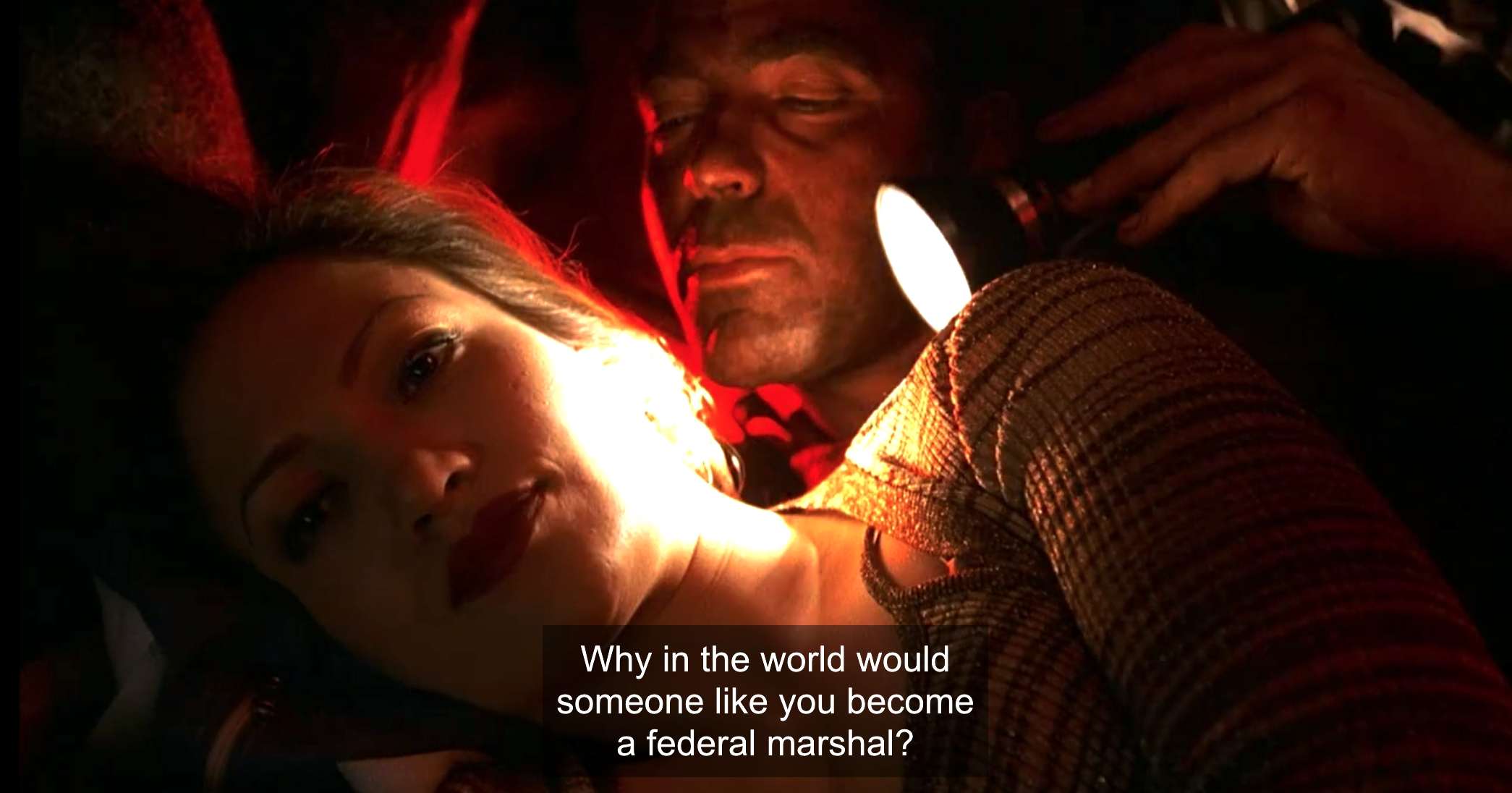
The Trunk Scene is just a few minutes of George Clooney and Jennifer Lopez trapped in extremely close quarters, talking to each other, trying to figure out who the other person is and what exactly they want, with a mutual infatuation building as the minutes and miles pass. There’s a touch of the “if you and I met under different circumstances” stuff that you see in movies like this, and a surprising lack of menace considering the whole “felon taking a woman hostage” aspect of it all, but mostly it is just captivating scene involving two charismatic actors and one talented director working together to make something special. It’s also one of the more improbable meet-cutes in movie history. It’s fun to think of it like that.
4. We should pause here to discuss the 1998 of it all. It’s easy to look back at this movie and see these names — CLOONEY, LOPEZ, SODERBERGH — that we’re conditioned to see attached to blockbusters and A-list events and forget there was context at play. They were all still known quantities at the time, sure, but not the all-caps figures I referenced in the previous sentence. Clooney was coming off a disastrous turn as Batman in Batman & Robin and was facing real questions about whether he was a legitimate movie star or just some TV haircut. Lopez had starred in Selena and Anaconda but had yet to release an album or wear that green Versace dress to the Grammys that helped catapult her into superstardom. Soderbergh was still a critical darling who had yet to truly crossover to mainstream success. This movie was in some ways the launching point for all of them, even if it wasn’t a massive box office success, just for the foundation it put down. Clooney and Soderbergh made the first Ocean’s movie a few years later. Lopez became J. Lo, international megastar, about a year later. This was lightning in a bottle, but not necessarily a surprise. It’s one of those movies where you go back and watch it for the 20th time to write an article about it and you find yourself saying “Oh, right. That’s why all these people are stars now.” Those are good kinds of movies.
5. The dialogue in this movie is incredible. Almost all of it, all the way through, especially the scenes where Clooney and Rhames are facing off with Cheadle (Elmore Leonard was a master at writing scenes where cool tough guys refuse to give each other an inch), but especially in the Bar Scene, also capitalized out of respect, in which Jack and Karen bump into each other in Detroit and have a passionate tryst in the midst of… everything.
It’s so good, starting with her blowing off the ad bros who try to hit on her (“Beat it, Andy”), moving through the part of the conversation where they pretend to be other people to make it all seem even five percent more normal (Gary and Celeste, just chatting), and onto the love scene itself intercut with the rest of their conversation. The whole thing is just about as good as you can do with any sort of romantic scene — electric without veering into parody, sultry without being gratuitous — from beginning to end. A reasonable argument can be made that it’s the single sexiest thing that has ever happened in Detroit.
6. It’s easy to come away from this movie focused on the Clooney-Soderbergh aspect of it, if only because it set the stage for a partnership and style that has continued for two decades, but do not overlook how good Jennifer Lopez is in Out of Sight. The degree of difficulty is through the roof here. She has to play a character who falls in love with the man who takes her hostage, who sleeps with the target of her own ongoing investigation, and who, at the beginning of the movie, is dating a huge doofus, and she still has to come out of it looking both strong and competent. That’s some kind of trick. There are tons of little moments that help drive this home (whacking creeps with a retractable blackjack helps), but my favorite is the moment where she’s staking out the hotel lobby and spots him in the elevator.
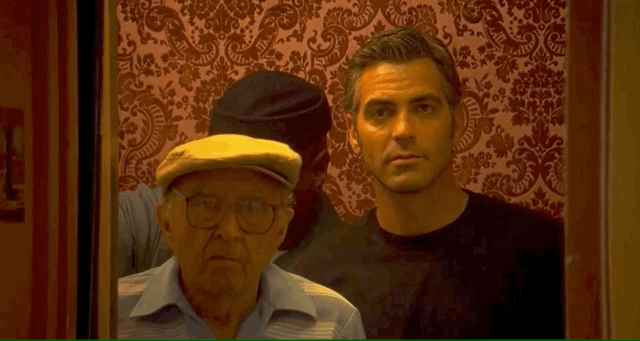
Lots of stuff going on right there, an entire film’s worth of built-up inner conflict, almost all of it in one facial expression. What I’m saying here is that Jennifer Lopez is pretty good at acting and has been for a while. In hindsight, I suspect I could have just typed that sentence instead of typing two paragraphs and cutting a GIF from the movie. But then I wouldn’t have gotten to mention her character’s doofus boyfriend, and it would have made for an awkward transition to my next point…
7. Michael Keaton is in Out of Sight, briefly, which is good, because Michael Keaton should appear in more movies for an amount of time greater than or equal to “briefly.” All of them, if possible. Look at this guy.
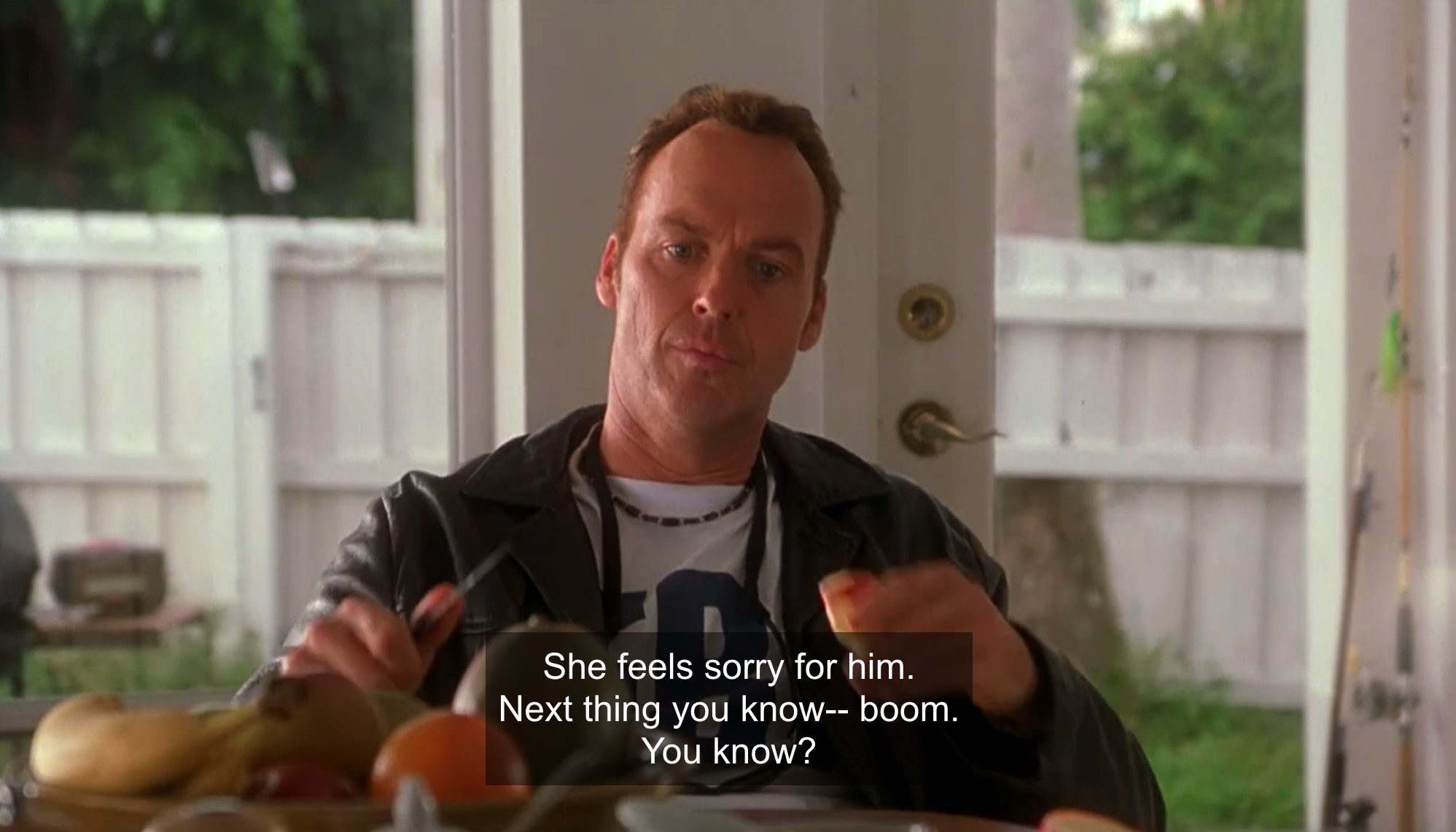
And it’s even cooler because the character he’s playing is an uncredited re-appearance of his character from Jackie Brown, FBI Agent Ray Nicolette, which implies that the movies exist in the same Elmore Leonard universe even though they were made by different studios. Soderbergh explained how it all went down in the director’s commentary, with the short explanation being “because Tarantino and Keaton were cool about it.”
We called up Tarantino and asked him what he thought of the idea and he thought it was a great idea, and he was nice enough to bring me into his editing room and show me all of Keaton’s footage from Jackie Brown so I could get an idea of where Keaton was going with that part, to see if it really fit with what we were doing. We got hold of Keaton and he came down and did this just as a favor for nothing, which was really nice of him. To our knowledge this was a first, a character who appears in two completely unrelated movies played by the same actor. As far as all of us could determine nobody had ever done this before, which was part of its appeal.
It does raise a few questions, though, in large part because the character Ray spends most of his appearance talking to is Karen’s father, played by Dennis Farina, who also appeared in Get Shorty as Miami mob figure Ray “Bones” Barboni. If we want to assume that all three films are connected (and I really do), this implies that there were two dudes in Miami on opposite sides of the law who looked exactly like Dennis Farina. (I would have watched this movie.) If we want to throw Get Shorty out of the equation to clean up the confusion, well… there’s still an issue we’ll get to in a minute. I’m very excited about it.
8. But back to the robbery. Things twist and turn and twist again until everyone ends up in the home of Albert Brooks’s character, who is now wearing a wig, and we learned earlier had kind of backed out of the deal he made with Jack in prison about giving him a job once they were out, which is what led to the tie-slamming and impromptu bank-robbing that started the movie. Don Cheadle’s character, Snoop, and his crew blow up a safe to discover it contains only more toupees. The diamonds turn out to be in the fish tank. Jack and Buddy make off with the diamonds and are in the clear but Jack goes back in because he feels guilty about Snoop planning to kill everyone. You know all of this. The important thing is that it leads to…
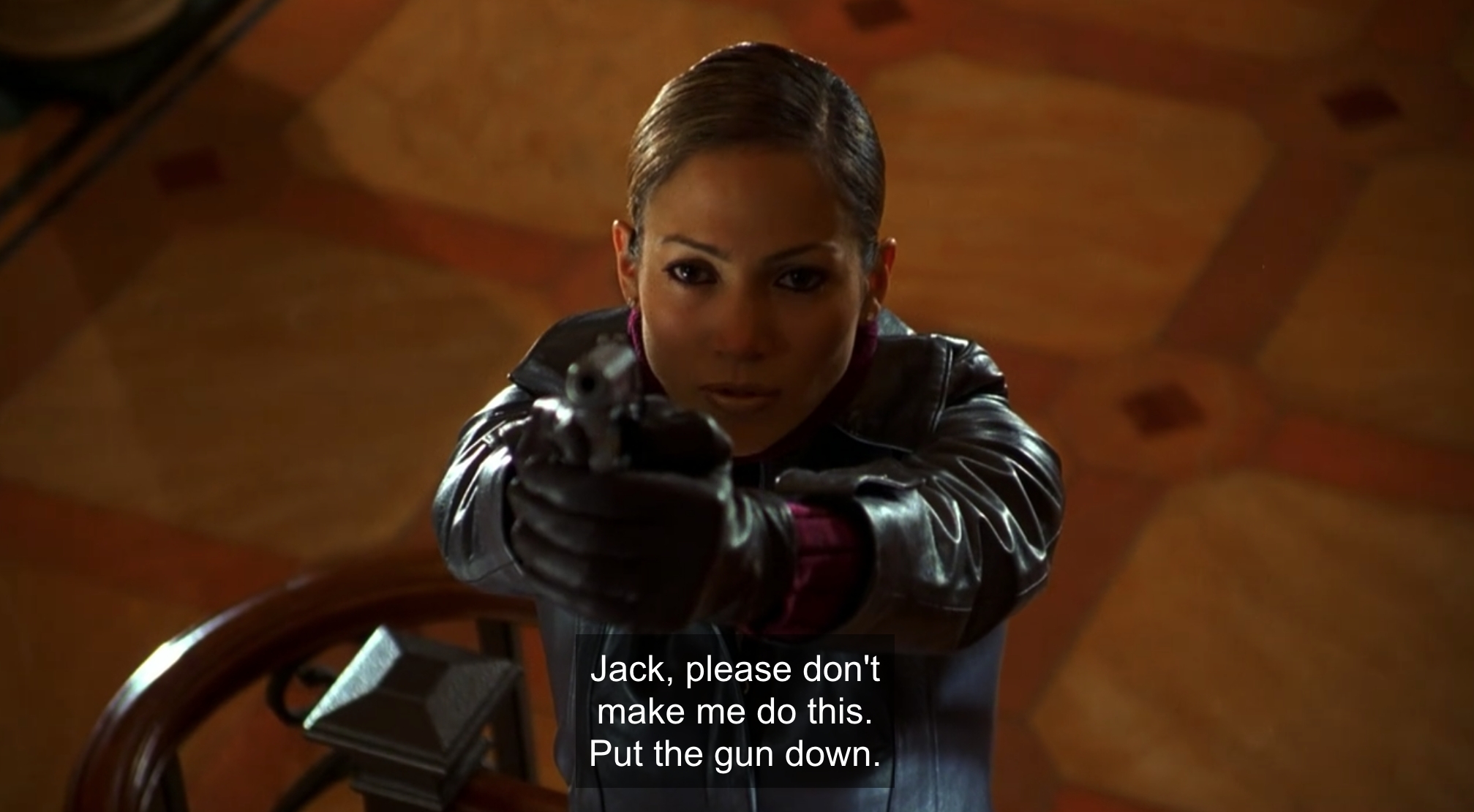
I should note here that the ending of the movie is different from the book, in ways that are probably more satisfying. The movie Hollywoods it up a bit, with the classic “I’m not going back”/“Don’t make me do it” scene resulting in a gunshot to a meaty part of Jack’s leg and an arrest. Buddy gets away with the diamonds. The violent bad guys die. Everything works out pretty well for everyone, really.
9. Well, almost everyone. Things did not work out too great for Snoop’s goon White Boy Bob. They started out great, with Bob raiding the fridge and making off with a bunch of steaks, which he was happier about than the diamonds. (I get it, Bob.) But then he had to rush up some steps to confront Jack and, well…
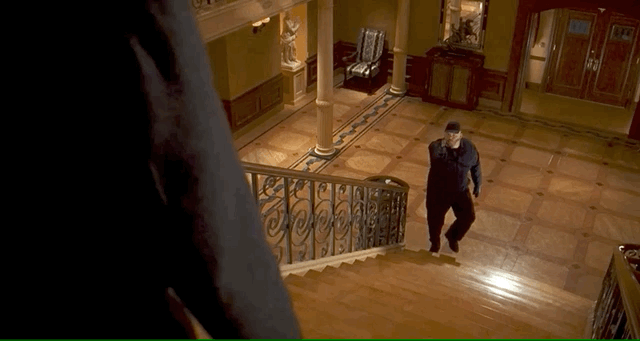
Blammo. Good night, Bob. It’s worth noting here, if only because there’s really no better excuse to note it, that this is not the only time a beefy character in an Elmore Leonard-inspired project has tripped and died by falling on his own weapon. It also happened to a goon in Justified. The lesson here is that this scene is always funny. And that Elmore Leonard was the best. So two lessons, I guess.
10. The fun thing about it all is that it means the movie is bookended by failed robberies. And it’s also, kind of, bookended by prison breaks. Or at least there’s an implied second prison break, as Karen pulls some strings to get Jack transported back to jail with a felon named Hejira Henry, who has himself orchestrated many prison breaks, and who presumably — based on a handful of glances and a devious little smile by Karen — will use the long car ride to become friends with Jack and start to plan another. It’s kind of sweet, in a way, and it would be the end of this discussion if not for one thing…
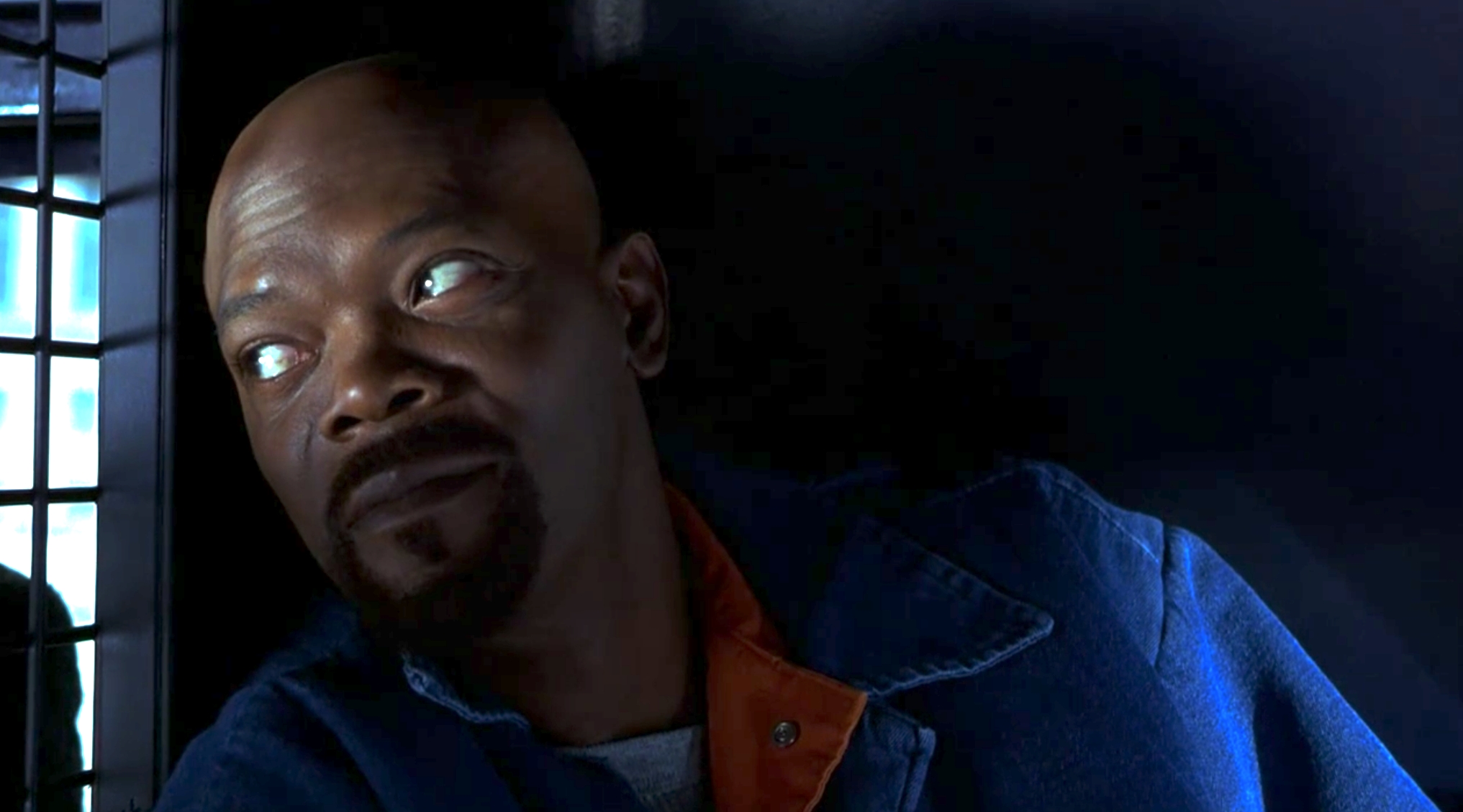
Hejira Henry is played by Samuel L. Jackson, in another uncredited role. That’s cool enough on its own, but consider this: Samuel L. Jackson played an arms dealer named Ordell Robbie in Jackie Brown. Do you see where I’m headed here? It’s the thing I mentioned earlier in the section about Michael Keaton. It is established fact that Jackie Brown and Out of Sight exist in the same universe, thanks to Ray Nicolette. Ordell Robbie and Hejira Henry are, presumably, not the same person. This means that, in this world, there are two different criminals who look exactly like Samuel L. Jackson, one of whom likes selling automatic weapons and drinking screwdrivers and one of whom breaks out of jail a lot. This is fascinating to me. I feel pretty confident that no one on Earth has spent more time than me thinking about it. I have, to be clear, no regrets about any of it. Well, maybe one regret, which is that I appear to be ending a lengthy discussion about a terrific movie with a lunatic rant about Samuel L. Jackson character. Hmm. Let’s fix that.
Out of Sight is a good movie. Still. Always.
